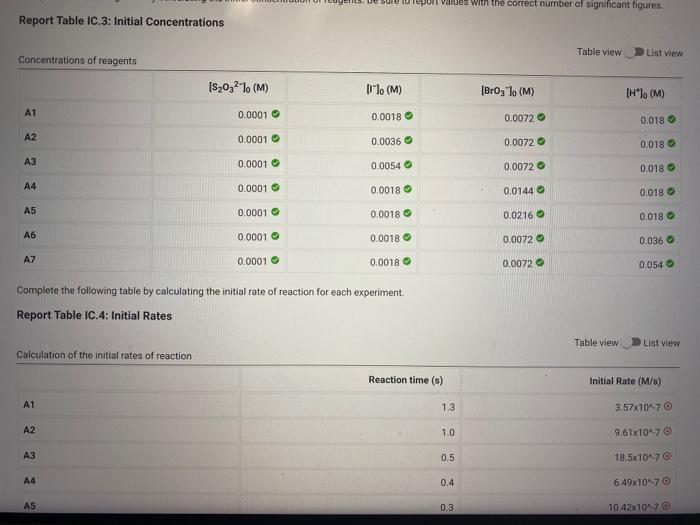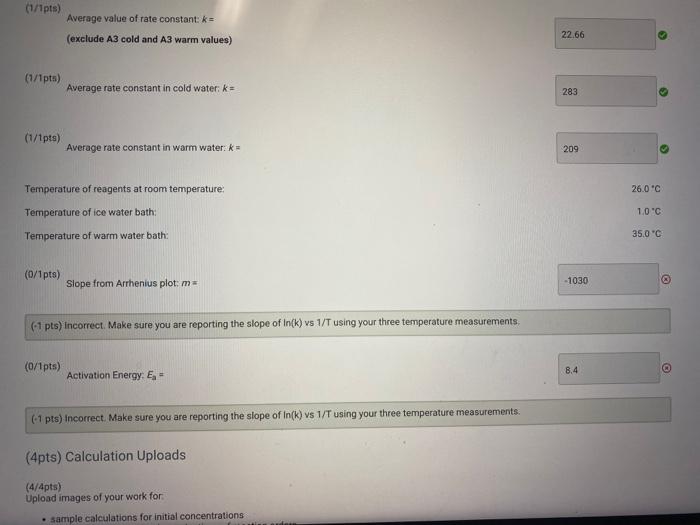Report - Kinetics of an lodine Clock Reaction (2pts) Kinetics of an lodine-clock Reaction How will you collect data for this experiment? Report Sheet Determining Reaction Orders Refer to the volumes in Table IC. 1 when preparing the reagents for experiments A1-A7. Temperature of reagents ("C) Note: Most stop-watches either report time in the format minutes. seconds or in the format minutesiseconds hundredths of a second. You will be entering time in seconds. For-example it a stop-watch that reported time to the second read 01:42, the time would be reported as 102 seconds, Whereas if a stop-watch that reported time to the hundreths of a second read 01:42:01, the time would be reported as 102.01 seconds. Report Table IC.1: Reaction Times Determining Activation Energy Report Table IC.2: Reaction Times for Hot and Cold Solutions Measurements of temperature and initial rates for reactions A3cold and A3hot (39pts) Initial Rates Report Table IC.3: Initial Concentrations Tableview 2 List view Complete the following table by calculating the initial rate of reaction for each experiment. Report Table IC.4: Initial Rates Calculation of the initial rates nf raartinn Table view List:view A1 Reaction time (s) Initial Rate (M/s) A2. A3 A4 AS A.6 A7 (1 pts) Incorrect. Use your concentration of thiosulfate and the reaction time for Experiment A1 to determine the intial rate of the reaction. (-1 pts) Incorrect. Use your concentration of thiosulfate and the reaction time for Experiment A2 to determine the intial rate of the reaction. (-1 pts) Incorrect. Use your concentration of thiosulfate and the reaction time for Experiment A3 to determine the intial rate of the reaction. (-1 pts) Incorrect. Use your concentration of thiosulfate and the reaction time for Experiment A4 to determine the intial rate of the reaction. (-1 pts) Incorrect. Use your concentration of thiosulfate and the reaction time for Experiment A5 to determine the intial rate of the reaction. (-1 pts) incorrect. Use your concentration of thiosulfate and the reaction time for Experiment A6 to determine the intial rate of the reaction. (-1 pts) Incorrect. Use your concentration of thiosulfate and the reaction time for Experiment A7 to determine the intial rate of the reaction. Complete the following table by calculating the initial rate of the reaction in cold and warm solutions. Report Table 1C.5: Initial Rates for Hot and Cold Solutions Calculation of the initial rates of reaction Table view List view (59pts) Rate Law Complete the following table by calculating reaction order of each reagent. Report Table IC.6: Determination of Reaction Orders Calculations for the reaction order of each reagent Table view Dist view (-1 pts) Based on the data you entered, your calculation of the exponent b for this pair of experiments is incorrect. Complete the following table by calculating the average reaction orders and then rounding each to an interger; Complete the following table by calculating the rate constant for each experiment at room temperature.. (11pts) Rate Constant Complete the following table by calculating the rate constant for each experiment at room temperature. Report Table IC.8: Rate Constants at Room Temperature Table view List view Complete the following table by calculating the rate constant for the warm and cold A3 solutions. Report Table IC.9: Rate Constants at Warm and Cold Temperatures Calculation of the rate constants at different temneratures Table view List view (-1 pts) Based on the data you entered, your calculation of the rate constant using this experiment is incorrect. (5pts) Determination of the Activation Energy Be sure to report values with the correct number of significant figures. (1/1pts) Average value of rate constant: k= (exclude A3 cold and A3 warm values) (1/1pts) Average rate constant in cold water: k= (1/1pts) Average rate constant in warm water: k= Temperature of reagents at room temperature: Temperature of ice water bath: Temperature of warm water bath: (1/1pts) Average value of rate constant k= (exclude A3 cold and A3 warm values) (1/1pts) Average rate constant in cold water: k= (1/1pts) Average rate constant in warm water: k= Temperature of reagents at room temperature: Temperature of ice water bath: Temperature of warm water bath: (0/1pts) Slope from Arrhenius plot: m= Report - Kinetics of an lodine Clock Reaction (2pts) Kinetics of an lodine-clock Reaction How will you collect data for this experiment? Report Sheet Determining Reaction Orders Refer to the volumes in Table IC. 1 when preparing the reagents for experiments A1-A7. Temperature of reagents ("C) Note: Most stop-watches either report time in the format minutes. seconds or in the format minutesiseconds hundredths of a second. You will be entering time in seconds. For-example it a stop-watch that reported time to the second read 01:42, the time would be reported as 102 seconds, Whereas if a stop-watch that reported time to the hundreths of a second read 01:42:01, the time would be reported as 102.01 seconds. Report Table IC.1: Reaction Times Determining Activation Energy Report Table IC.2: Reaction Times for Hot and Cold Solutions Measurements of temperature and initial rates for reactions A3cold and A3hot (39pts) Initial Rates Report Table IC.3: Initial Concentrations Tableview 2 List view Complete the following table by calculating the initial rate of reaction for each experiment. Report Table IC.4: Initial Rates Calculation of the initial rates nf raartinn Table view List:view A1 Reaction time (s) Initial Rate (M/s) A2. A3 A4 AS A.6 A7 (1 pts) Incorrect. Use your concentration of thiosulfate and the reaction time for Experiment A1 to determine the intial rate of the reaction. (-1 pts) Incorrect. Use your concentration of thiosulfate and the reaction time for Experiment A2 to determine the intial rate of the reaction. (-1 pts) Incorrect. Use your concentration of thiosulfate and the reaction time for Experiment A3 to determine the intial rate of the reaction. (-1 pts) Incorrect. Use your concentration of thiosulfate and the reaction time for Experiment A4 to determine the intial rate of the reaction. (-1 pts) Incorrect. Use your concentration of thiosulfate and the reaction time for Experiment A5 to determine the intial rate of the reaction. (-1 pts) incorrect. Use your concentration of thiosulfate and the reaction time for Experiment A6 to determine the intial rate of the reaction. (-1 pts) Incorrect. Use your concentration of thiosulfate and the reaction time for Experiment A7 to determine the intial rate of the reaction. Complete the following table by calculating the initial rate of the reaction in cold and warm solutions. Report Table 1C.5: Initial Rates for Hot and Cold Solutions Calculation of the initial rates of reaction Table view List view (59pts) Rate Law Complete the following table by calculating reaction order of each reagent. Report Table IC.6: Determination of Reaction Orders Calculations for the reaction order of each reagent Table view Dist view (-1 pts) Based on the data you entered, your calculation of the exponent b for this pair of experiments is incorrect. Complete the following table by calculating the average reaction orders and then rounding each to an interger; Complete the following table by calculating the rate constant for each experiment at room temperature.. (11pts) Rate Constant Complete the following table by calculating the rate constant for each experiment at room temperature. Report Table IC.8: Rate Constants at Room Temperature Table view List view Complete the following table by calculating the rate constant for the warm and cold A3 solutions. Report Table IC.9: Rate Constants at Warm and Cold Temperatures Calculation of the rate constants at different temneratures Table view List view (-1 pts) Based on the data you entered, your calculation of the rate constant using this experiment is incorrect. (5pts) Determination of the Activation Energy Be sure to report values with the correct number of significant figures. (1/1pts) Average value of rate constant: k= (exclude A3 cold and A3 warm values) (1/1pts) Average rate constant in cold water: k= (1/1pts) Average rate constant in warm water: k= Temperature of reagents at room temperature: Temperature of ice water bath: Temperature of warm water bath: (1/1pts) Average value of rate constant k= (exclude A3 cold and A3 warm values) (1/1pts) Average rate constant in cold water: k= (1/1pts) Average rate constant in warm water: k= Temperature of reagents at room temperature: Temperature of ice water bath: Temperature of warm water bath: (0/1pts) Slope from Arrhenius plot: m=















